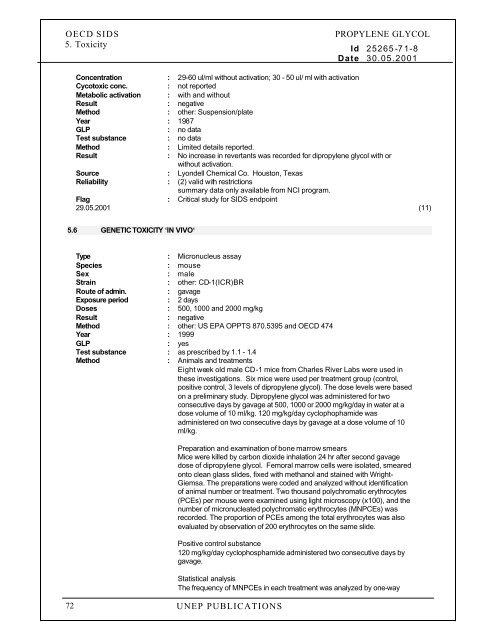Dipropylene glycol (SIDS)
Dipropylene glycol (SIDS)
Dipropylene glycol (SIDS)
You also want an ePaper? Increase the reach of your titles
YUMPU automatically turns print PDFs into web optimized ePapers that Google loves.
OECD <strong>SIDS</strong> PROPYLENE GLYCOL<br />
5. Toxicity<br />
Id 25265-71-8<br />
Date 30.05.2001<br />
Concentration : 29-60 ul/ml without activation; 30 - 50 ul/ ml with activation<br />
Cycotoxic conc. : not reported<br />
Metabolic activation : with and without<br />
Result : negative<br />
Method : other: Suspension/plate<br />
Year : 1987<br />
GLP : no data<br />
Test substance : no data<br />
Method : Limited details reported.<br />
Result : No increase in revertants was recorded for dipropylene <strong>glycol</strong> with or<br />
without activation.<br />
Source : Lyondell Chemical Co. Houston, Texas<br />
Reliability : (2) valid with restrictions<br />
summary data only available from NCI program.<br />
Flag : Critical study for <strong>SIDS</strong> endpoint<br />
29.05.2001 (11)<br />
5.6 GENETIC TOXICITY ‘IN VIVO‘<br />
Type : Micronucleus assay<br />
Species : mouse<br />
Sex : male<br />
Strain : other: CD-1(ICR)BR<br />
Route of admin. : gavage<br />
Exposure period : 2 days<br />
Doses : 500, 1000 and 2000 mg/kg<br />
Result : negative<br />
Method : other: US EPA OPPTS 870.5395 and OECD 474<br />
Year : 1999<br />
GLP : yes<br />
Test substance : as prescribed by 1.1 - 1.4<br />
Method : Animals and treatments<br />
Eight week old male CD-1 mice from Charles River Labs were used in<br />
these investigations. Six mice were used per treatment group (control,<br />
positive control, 3 levels of dipropylene <strong>glycol</strong>). The dose levels were based<br />
on a preliminary study. <strong>Dipropylene</strong> <strong>glycol</strong> was administered for two<br />
consecutive days by gavage at 500, 1000 or 2000 mg/kg/day in water at a<br />
dose volume of 10 ml/kg. 120 mg/kg/day cyclophophamide was<br />
administered on two consecutive days by gavage at a dose volume of 10<br />
ml/kg.<br />
Preparation and examination of bone marrow smears<br />
Mice were killed by carbon dioxide inhalation 24 hr after second gavage<br />
dose of dipropylene <strong>glycol</strong>. Femoral marrow cells were isolated, smeared<br />
onto clean glass slides, fixed with methanol and stained with Wright-<br />
Giemsa. The preparations were coded and analyzed without identification<br />
of animal number or treatment. Two thousand polychromatic erythrocytes<br />
(PCEs) per mouse were examined using light microscopy (x100), and the<br />
number of micronucleated polychromatic erythrocytes (MNPCEs) was<br />
recorded. The proportion of PCEs among the total erythrocytes was also<br />
evaluated by observation of 200 erythrocytes on the same slide.<br />
Positive control substance<br />
120 mg/kg/day cyclophosphamide administered two consecutive days by<br />
gavage.<br />
Statistical analysis<br />
The frequency of MNPCEs in each treatment was analyzed by one-way<br />
72<br />
UNEP PUBLICATIONS
















